非谓语动词之动词不定式(todo)的用法
总结todo的用法(精选4篇)
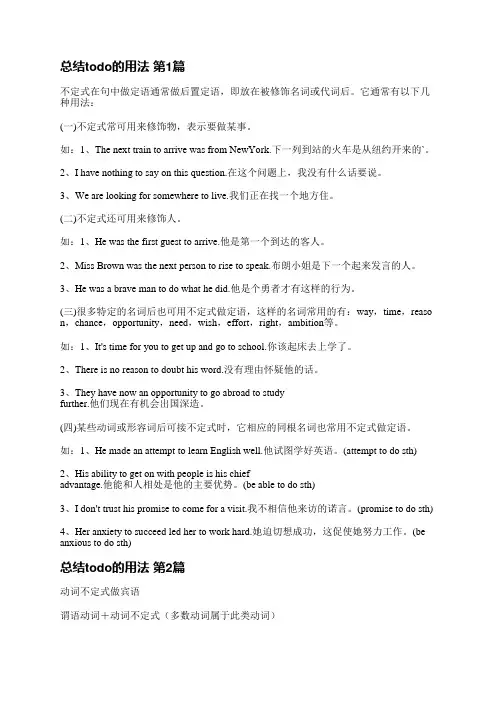
总结todo的用法第1篇不定式在句中做定语通常做后置定语,即放在被修饰名词或代词后。
它通常有以下几种用法:(一)不定式常可用来修饰物,表示要做某事。
如:1、The next train to arrive was from NewYork.下一列到站的火车是从纽约开来的`。
2、I have nothing to say on this question.在这个问题上,我没有什么话要说。
3、We are looking for somewhere to live.我们正在找一个地方住。
(二)不定式还可用来修饰人。
如:1、He was the first guest to arrive.他是第一个到达的客人。
2、Miss Brown was the next person to rise to speak.布朗小姐是下一个起来发言的人。
3、He was a brave man to do what he did.他是个勇者才有这样的行为。
(三)很多特定的名词后也可用不定式做定语,这样的名词常用的有:way,time,reaso n,chance,opportunity,need,wish,effort,right,ambition等。
如:1、It's time for you to get up and go to school.你该起床去上学了。
2、There is no reason to doubt his word.没有理由怀疑他的话。
3、They have now an opportunity to go abroad to studyfurther.他们现在有机会出国深造。
(四)某些动词或形容词后可接不定式时,它相应的同根名词也常用不定式做定语。
如:1、He made an attempt to learn English well.他试图学好英语。
(attempt to do sth) 2、His ability to get on with people is his chiefadvantage.他能和人相处是他的主要优势。
非谓语动词之动词不定式(to do)的用法
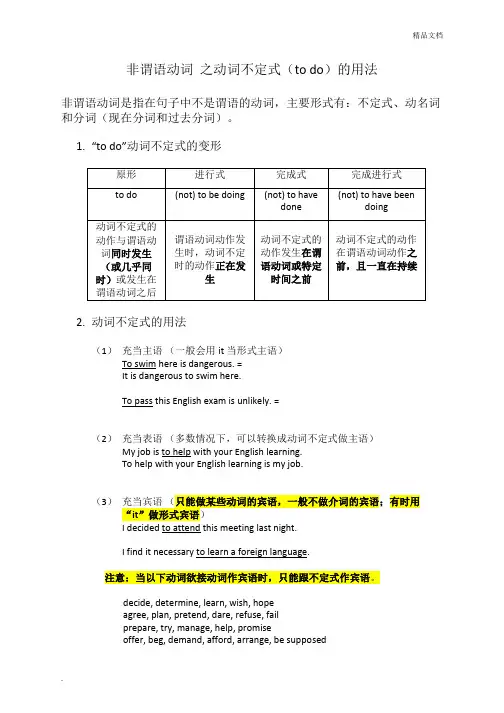
非谓语动词之动词不定式(to do)的用法非谓语动词是指在句子中不是谓语的动词,主要形式有:不定式、动名词和分词(现在分词和过去分词)。
1.“to do”动词不定式的变形2.动词不定式的用法(1)充当主语(一般会用it 当形式主语)To swim here is dangerous. =It is dangerous to swim here.To pass this English exam is unlikely. =(2)充当表语(多数情况下,可以转换成动词不定式做主语)My job is to help with your English learning.To help with your English learning is my job.(3)充当宾语(只能做某些动词的宾语,一般不做介词的宾语;有时用“it”做形式宾语)I decided to attend this meeting last night.I find it necessary to learn a foreign language.注意:当以下动词欲接动词作宾语时,只能跟不定式作宾语。
decide, determine, learn, wish, hopeagree, plan, pretend, dare, refuse, failprepare, try, manage, help, promiseoffer, beg, demand, afford, arrange, be supposed(4)充当宾语补足语I persuaded him to make a speech in public.注意:在感官动词/使役动词/help后(see, hear, watch, notice, make,have, let后不定式做宾补时,可省略“to”)I saw them have a disagreement on who should sweep the floor. (我看到了他们争论的整个过程)但,感官动词后面也可接Ving形式,表示正在进行。
非谓语动词之动词不定式(todo)的用法
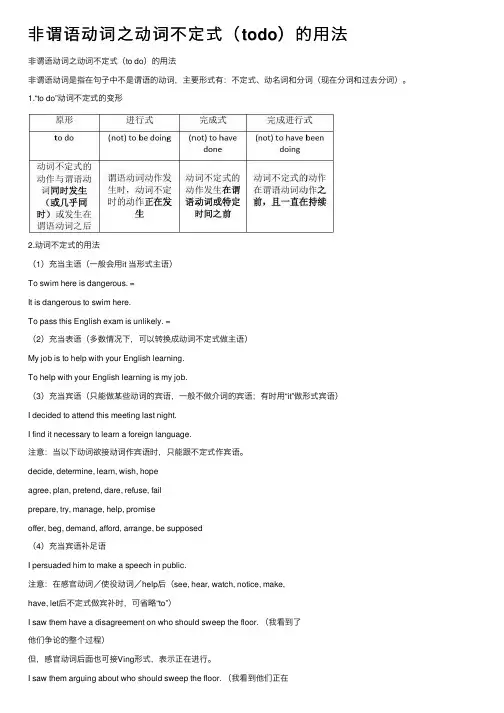
⾮谓语动词之动词不定式(todo)的⽤法⾮谓语动词之动词不定式(to do)的⽤法⾮谓语动词是指在句⼦中不是谓语的动词,主要形式有:不定式、动名词和分词(现在分词和过去分词)。
1.“to do”动词不定式的变形2.动词不定式的⽤法(1)充当主语(⼀般会⽤it 当形式主语)To swim here is dangerous. =It is dangerous to swim here.To pass this English exam is unlikely. =(2)充当表语(多数情况下,可以转换成动词不定式做主语)My job is to help with your English learning.To help with your English learning is my job.(3)充当宾语(只能做某些动词的宾语,⼀般不做介词的宾语;有时⽤“it”做形式宾语)I decided to attend this meeting last night.I find it necessary to learn a foreign language.注意:当以下动词欲接动词作宾语时,只能跟不定式作宾语。
decide, determine, learn, wish, hopeagree, plan, pretend, dare, refuse, failprepare, try, manage, help, promiseoffer, beg, demand, afford, arrange, be supposed(4)充当宾语补⾜语I persuaded him to make a speech in public.注意:在感官动词/使役动词/help后(see, hear, watch, notice, make,have, let后不定式做宾补时,可省略“to”)I saw them have a disagreement on who should sweep the floor. (我看到了他们争论的整个过程)但,感官动词后⾯也可接Ving形式,表⽰正在进⾏。
英语中不定式(todo)的6种成分和2种独立用法

英语中不定式(todo)的6种成分和2种独立用法非谓语是英语学习的重点也是难点,很多同学对这个语法知识一直是处于比较懵的状态。
其实只要掌握非谓语所充当成分的用法就可以运用自如了。
非谓语,顾名思义就是不做谓语的动词的变化形式,即to do ,doing,done。
除了谓语,句子成分中还有主语、宾语、表语、宾语补足语、定语和状语。
下面看看不定式(to do)充当这6种成分的用法:一、不定式作主语1.To see is to believe. (这种情况不常用)2. It is important to learn English well.It 是形式主语,真正的主语是 to learn English well. 这种用法是常用的而且是考点!考点!考点!二、不定式作表语:常说明主语的内容、性质和特征或表动作将要发生。
1. My job is to keep the children safe.2.My task is to type the article.三、不定式做宾语1.He prefers to eat white bread and rice.2.He wants to play football.3.动词feel, find, make, think等后面,可以用it作形式宾语代替真正的宾语——动词不定式,句子结构是...feel / find / make / ... it+adj. / n.+to do...。
如:I find it difficult to remember everything.常接动词不定式作宾语的动词有:(需要记住)agree, afford, appear, ask, attempt;care, choose, claim;dare,decide,demand,deserve,determine;expect, fail, get, guarantee;hate, hesitate, hope, hurry;intend, learn, manage, offer,plan, prepare, pretend, promise;refuse, seem, tend, threaten;want, wish 等四、不定式做宾语补足语1.I'd invite her to have dinner at my house.2 . We should allow the children to choose their own clothes.Note 1: 带to的动词不定式作宾语补足语的动词主要有:要求允许提议(ask, allow, advise),期望邀请鼓励(expect, invite, encourage),教导告诉想要(teach, tell, want),等待希望愿意(wait for, wish, would like / love)。
高中英语语法:非谓语复习之to do用法大全
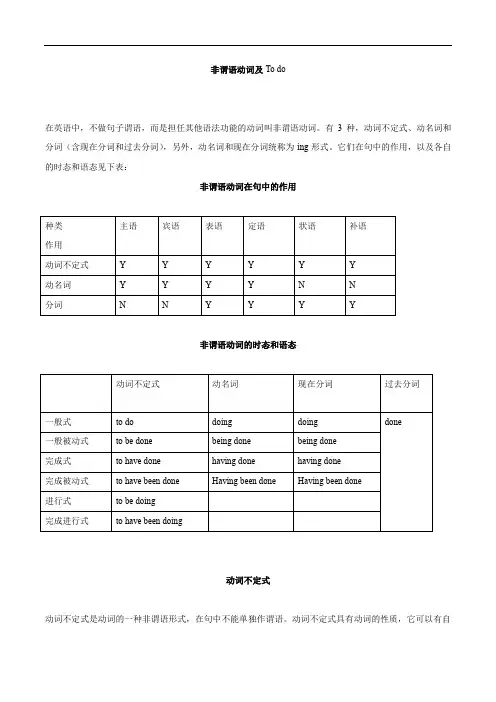
非谓语动词及To do在英语中,不做句子谓语,而是担任其他语法功能的动词叫非谓语动词。
有3种,动词不定式、动名词和分词(含现在分词和过去分词),另外,动名词和现在分词统称为-ing形式。
它们在句中的作用,以及各自的时态和语态见下表:非谓语动词在句中的作用非谓语动词的时态和语态动词不定式动词不定式是动词的一种非谓语形式,在句中不能单独作谓语。
动词不定式具有动词的性质,它可以有自己的宾语和状语,从而构成动词不定式短语。
它还可以有形式的变化,即一般式、进行式、完成式和被动式。
同时,动词不定式也具有非动词的性质,相当于一个名词、形容词或副词,可以在句中担任主语、宾语、宾语补足语、表语、定语和状语。
一、动词不定式的特征和种类动词不定式是由不定式符号to+动词原形构成,在某些情况下to也可省略。
(一)不定式的一般式不定式的一般式表示的动作通常与主要谓语的动作同时或几乎同时发生,或是在它之后发生。
He appears to be very happy.他看起来好像很高兴。
(同时发生)To catch the train, we'd better hurry to the station by taxi.为了赶上火车,我们最好赶紧乘出租车去车站。
(to catch the train发生在hurry to the station之后)(二)不定式的进行式不定式的进行式表示正在进行的或与谓语动词同时发生的动作。
It happened to be raining when I got there.我到达那里的时候,天碰巧在下雨。
I'm glad to be traveling with you.我很高兴和你一起旅游。
(三)不定式的完成式不定式的完成式表示的动作在谓语表示的动作之前发生。
I'm sorry to have lost your key.我很抱歉把你的钥匙弄丢了。
I meant to have finished my work last night, but I didn't feel very well.我本来想昨晚完成工作的,但是我感觉身体不舒服。
不定式to do的用法
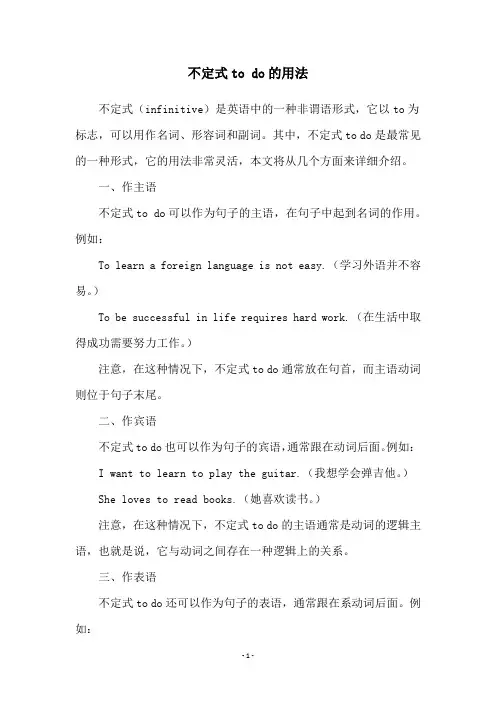
不定式to do的用法不定式(infinitive)是英语中的一种非谓语形式,它以to为标志,可以用作名词、形容词和副词。
其中,不定式to do是最常见的一种形式,它的用法非常灵活,本文将从几个方面来详细介绍。
一、作主语不定式to do可以作为句子的主语,在句子中起到名词的作用。
例如:To learn a foreign language is not easy.(学习外语并不容易。
)To be successful in life requires hard work.(在生活中取得成功需要努力工作。
)注意,在这种情况下,不定式to do通常放在句首,而主语动词则位于句子末尾。
二、作宾语不定式to do也可以作为句子的宾语,通常跟在动词后面。
例如: I want to learn to play the guitar.(我想学会弹吉他。
)She loves to read books.(她喜欢读书。
)注意,在这种情况下,不定式to do的主语通常是动词的逻辑主语,也就是说,它与动词之间存在一种逻辑上的关系。
三、作表语不定式to do还可以作为句子的表语,通常跟在系动词后面。
例如:His dream is to become a doctor.(他的梦想是成为一名医生。
) The most important thing is to be happy.(最重要的是要快乐。
)注意,在这种情况下,不定式to do通常用作名词,起到表达主语属性的作用。
四、作定语不定式to do还可以用作定语,修饰名词或代词。
例如:I have a lot of work to do.(我有很多事情要做。
)She is the first person to arrive.(她是第一个到达的人。
)注意,在这种情况下,不定式to do通常用作形容词,起到限定名词或代词的作用。
五、作状语不定式to do还可以用作状语,表示目的、结果、原因等。
非谓语动词to do不定式讲解
非谓语动词to do不定式讲解
非谓语动词中的to do不定式是英语语法中的一个重要部分,它表示动作尚未发生或即将发生,具有不确定性。
以下是关于to do不定式的详细讲解:
1. 用法:to do不定式在句子中可以作主语、宾语、表语、定语、状语等成分,用于表达各种不同的意义和语气。
2. 时态:to do不定式有多种时态形式,包括一般式(to do)、进行式(to be doing)、完成式(to have done)等,根据不同的语境选择不同的时态形式。
3. 语态:to do不定式有被动语态和主动语态两种形式。
被动语态用于表示主语是动作的接受者,主动语态表示主语是动作的执行者。
4. 否定形式:to do不定式的否定形式是在前面加上“not”或者“never”,例如“to not do”或者“never to do”。
5. 独立结构:在某些情况下,to do不定式可以作为独立结构出现,例如“To err is human.(人非圣贤,孰能无过。
)”。
6. 习惯搭配:to do不定式常常与一些固定搭配一起使用,例如“want to do”(想要做)、“plan to do”(计划做)等。
总之,to do不定式是一个非常灵活的非谓语动词形式,在不同的语境中有不同的用法和意义。
通过掌握其基本用法和规则,能够更好地理解和运用这种语言现象,提高英语表达能力。
第1讲非谓语动词不定式todo的用法
非谓语动词不定式非谓语动词——不定式不定式的2种形式不定式在句子中的成分say is easy and is hard.主语主语To say is easy and is hard.To see is to believe.主语’s +adj. for sb. to do sth.形式主语真正主语该类形容词有:difficult/hard/important/possible/adj. 修饰sth. j dj f b h 形式主语真正主语impossible/comfortable/necessary 等该类形容词有:adj. 修饰sb.’s +adj. of sb. to do sth.类形容有kind/nice/stupid/rude/clever/foolish/thoughtful/brave/considerate 等It ’s interesting It ’s kind of you to help To see is to believe 表语To see is to believe .对于一个老师来说最重要的事The most important thing for a 是公平地对待每个学生.The most important thing for a teacher is to treat every student equally.三. 作宾语The bird wants to find something to drink.宾语+不定式作宾语的动词有:三个希望两答应:hope, wish, want, agree, promise 两个要求未拒绝:设法学会做决定:不需假装在选择p ,,,g ,p demand, ask, fail, refuse manage, intend, learn, decide, determine 不需假装在选择:desire, pretend, choose But the bird found it hard to find water.主语+find/think +it + adj. + to do sth.形式宾语真正宾语j 宾补asks me to do exercises.主谓关系advise, allow, ask, wish ll h want, get, order, tell, teachTo make me study better, my mother asks me to do exercises.make me study (省略to 的)宾补的宾补的动词有:,y y listen to, hear)let,have)make, let, have) see, notice, observe, watch)注意:五. 作定语作定语The bird wants to find something to drink 定语The bird wants to find something to drink .I want to find a comfortable pillow to lie on.d b 目的状语To make me study better , my mother exercises.The cat is too control itself 结果状语The cat is too excitedto control itself .---Lucy had a bad cold. ---I am sorry to hear that.原因状语o e .to leave didn’t tell his 宾语when to leave and t tell his how to improve their products.宾语The man lost his way, so he didn’t know where to go.。
非谓语to do
(一)非谓语动词概述动词在句中除充当谓语外,还可以起名词、形容词或副词的作用。
在句中充当主语、宾语、表语、补语、定语和状语。
这就是动词的非谓语形式。
当句中需要用某种动作作主语、宾语或作某种修饰、说明的成分时,就要用这种形式。
动词非谓语形式有三种:动词不定式to do,分词(现在分词doing和过去分词done)和动名词doing,动词非谓语形式仍具有动词的一般特征,可以带有宾语、状语等构成短语。
(二)动词不定式动词不定式能起名词、形容词和副词作用,充当谓语以外的各种成分。
1. 作主语:不定式可以直接放在句首做一句话的主语, it 做形式主语,to do 后置。
To learn English is not an easy thing . It is important to protect our environment .2. 作宾语:接to do作宾语的动词:want decide/determine agree would like hope wish like hate prefercontinue paln attempt promise intend afford offer fail refuse agree...He wants to visit Nanjing . Mary decided to go alone .3.作宾语补足语:1) want , would like , wish , ask , tell , expect advise allow ...sb+to doI’d like you to help me with my English exercises.2)“使役动词”:let , have , make&感官动词hear / see / notice /notice/observe / feel…+宾语+do(感官动词还可以加doing作宾语补足语)The landlord made my grandfather work in the field all day(改成被动句).I often hear her sing. & I heard her singing when I passed by room this morning.3)think consider believe find imagine...sb +(to be)+n/adj.I thought her(to be) nice and honest the first time I saw her.When she woke up, she found herself (to be)badly injured.4). Think consider find it(形式宾语)+adj+to doI find it easy to get along with him. I think it important to learn English well.4. 作表语:如:The young man seems to be a college graduate . To see is to believe . 百闻不如一见。
非谓语动词todo的用法小结
非谓语动词不定式(to do)的用法小结I.不定式的语法意义1.不定式具有名词、形容词、副词的特征,在句中可作主、宾、定、表、补和状语。
2.没有人称和数的变化,在句子中不能作谓语,但有时态和语态的变化。
3.仍保留动词的特征,即可有自己的宾语和状语,和他们一起构成不定式短语。
II. 不定式的否定式not to doIII.不定式的时态和语态1.一般式(to do/to be done)表示动作或状态与谓语动词的动作或状态同时发生或发生在其后。
2.完成式(to have done/to have been done)表示动作或状态在谓语动词的动作或状态之前。
3.进行式(to be doing)表示动作谓语动词所表示的动作或状态发生时正在发生。
4.完成进行式(to have been doing)表示在谓语动词的动作或状态发生之前开始进行的行为,到谓语动作发生时,可能停止,也可能会持续下去。
IV.不定式的功能1.作主语:(1)to do可直接作主语,表示特指一个具体动作。
eg.To swim in that river is very dangerous.To study English well isn’teasy.(2) 用it作为形式主语,而把真正的不定式主语放到句中。
常见的有6种。
It is +adj+ to do sth.eg.It is nice not to be dependent onothers.It is +adj+for sb to do sth.eg.It is not hard for one to do a bit of goodIt is +adj+of sb to do sth.eg. It is silly of you to believe him.= You are silly to believe him.It is +noun+to do sth.eg.It was not his habit to ask people for things.It+动词(+宾语)+ to do sth.eg.It took me a year to finish writing thebook.It is+介词短语+to do sth.eg.It is beyond my power to answer this question.2.作表语:to do作表语很普遍,多数情况下可换作主语eg.Her job is to teach us maths.To teach us maths is her job.3.作宾语:to do作宾语直接跟在vt 动词后面。
- 1、下载文档前请自行甄别文档内容的完整性,平台不提供额外的编辑、内容补充、找答案等附加服务。
- 2、"仅部分预览"的文档,不可在线预览部分如存在完整性等问题,可反馈申请退款(可完整预览的文档不适用该条件!)。
- 3、如文档侵犯您的权益,请联系客服反馈,我们会尽快为您处理(人工客服工作时间:9:00-18:30)。
非谓语动词之动词不定式(to do)的用法
非谓语动词是指在句子中不是谓语的动词,主要形式有:不定式、动名词和分词(现在分词和过去分词)。
“to do”动词不定式的变形
动词不定式的用法
充当主语(一般会用it 当形式主语)
To swim here is dangerous. =
It is dangerous to swim here.
To pass this English exam is unlikely. =
充当表语(多数情况下,可以转换成动词不定式做主语)
My job is to help with your English learning.
To help with your English learning is my job.
充当宾语(只能做某些动词的宾语,一般不做介词的宾语;有时用“it”做形式宾语)
I decided to attend this meeting last night.
I find it necessary to learn a foreign language.
注意:当以下动词欲接动词作宾语时,只能跟不定式作宾语。
decide, determine, learn, wish, hope
agree, plan, pretend, dare, refuse, fail
prepare, try, manage, help, promise
offer, beg, demand, afford, arrange, be supposed
充当宾语补足语
I persuaded him to make a speech in public.
注意:在感官动词/使役动词/help后(see, hear, watch, notice, make, have, let后不定式做宾补时,可省略“to”)
I saw them have a disagreement on who should sweep the floor. (我看到了他们争论的整个过程)
但,感官动词后面也可接Ving形式,表示正在进行。
I saw them arguing about who should sweep the floor. (我看到他们正在争论谁该扫地,并不一定看到了整个过程)
充当状语(目的,原因,结果状语,其逻辑主语与句子主语一致)
I wrote him a letter to further explain this matter. (目的状语)
I’m sorry to bother you.(原因状语)
He queued for hours at the box office only to find that the show was sold out. (结果状语,only + to find/realize/discover表示出乎意料的结果)
充当定语(不定式作定语,要放在所修饰的词的后面)
I have a lot of dishes to wash.
Do you have anything to say
There are 3 questions to answer.
一些固定句型中不定式省略“to”
had better
would rather do… than do…
why not do
“except/but” 有“do” 无“to”,有”to”无“do”
have nothing to do but do…
do everything but/except
have no choice but to
want nothing but/except to
当两个或多个作用相同的不定式并列(and/or/than)时,通常只保留第一个不定式的“to”.
He told me to stay there and wait for him.
It’s easier to persuade people than force them.
To try and fail is better than not to try at all. (否定式中“to”不能省略)
习题:
1. It’s great ________ (hear) this news that China team won the match.
2. He pretended ________ (sleep) when his younger brother came in.
3. We agreed ________ (meet) here but so far she has not turned up yet.
4. Although regular exercise is very important, it’s never a good idea ________ (exercise) too close to bedtime.
5. It’s going to rain. You’d better ________ (bring) the umbrella with you when going out.
6. You don’t have to run fast for long _______ (see) the benefit.。
